Foreword / YouTube Video Review
The review on this website is a brief overview and summary of the objective performance of this speaker. It is not intended to be a deep dive. Moreso, this is information for those who prefer “just the facts” and prefer to have the data without the filler.
For a primer on what the data means, please watch my series of videos where I provide in-depth discussion and examples of how to read the graphics presented hereon.
Information and Photos
The Kef R8a is 2-way concentric Atmos speaker. It features a 5.25-inch concentric “Uni-Q” midrange/tweeter in a sealed cabinet. The crossover between the 2.0kHz.
Price is approximately $1400 USD for a pair.
CTA-2034 (SPINORAMA) and Accompanying Data
All data collected using Klippel’s Near-Field Scanner. The Near-Field-Scanner 3D (NFS) offers a fully automated acoustic measurement of direct sound radiated from the source under test. The radiated sound is determined in any desired distance and angle in the 3D space outside the scanning surface. Directivity, sound power, SPL response and many more key figures are obtained for any kind of loudspeaker and audio system in near field applications (e.g. studio monitors, mobile devices) as well as far field applications (e.g. professional audio systems). Utilizing a minimum of measurement points, a comprehensive data set is generated containing the loudspeaker’s high resolution, free field sound radiation in the near and far field. For a detailed explanation of how the NFS works and the science behind it, please watch the below discussion with designer Christian Bellmann:
The reference plane in this test is at the tweeter/midrange. The speaker was laid on its side for testing (shown below) but the results are given as if the speaker were pointed directly at the listener (not angled down or up, either). This speaker is designed to be placed on top of a speaker or wall-mounted. Therefore, the configuration I tested this speaker in should be considered … basically you just flip the vertical/horizontal results mentally if you plan to put this on top of a speaker, firing up toward the ceiling. Then you’ll have the speaker as if it were pointed up. Otherwise, the results are given as if the speaker were wall-mounted, pointed down toward the listener. This review was done without grille.
Measurements are provided in a format in accordance with the Standard Method of Measurement for In-Home Loudspeakers (ANSI/CTA-2034-A R-2020). For more information, please see this link.
CTA-2034 / SPINORAMA:
The On-axis Frequency Response (0°) is the universal starting point and in many situations it is a fair representation of the first sound to arrive at a listener’s ears.
The Listening Window is a spatial average of the nine amplitude responses in the ±10º vertical and ±30º horizontal angular range. This encompasses those listeners who sit within a typical home theater audience, as well as those who disregard the normal rules when listening alone.
The Early Reflections curve is an estimate of all single-bounce, first-reflections, in a typical listening room.
Sound Power represents all of the sounds arriving at the listening position after any number of reflections from any direction. It is the weighted rms average of all 70 measurements, with individual measurements weighted according to the portion of the spherical surface that they represent.
Sound Power Directivity Index (SPDI): In this standard the SPDI is defined as the difference between the listening window curve and the sound power curve.
Early Reflections Directivity Index (EPDI): is defined as the difference between the listening window curve and the early reflections curve. In small rooms, early reflections figure prominently in what is measured and heard in the room so this curve may provide insights into potential sound quality.
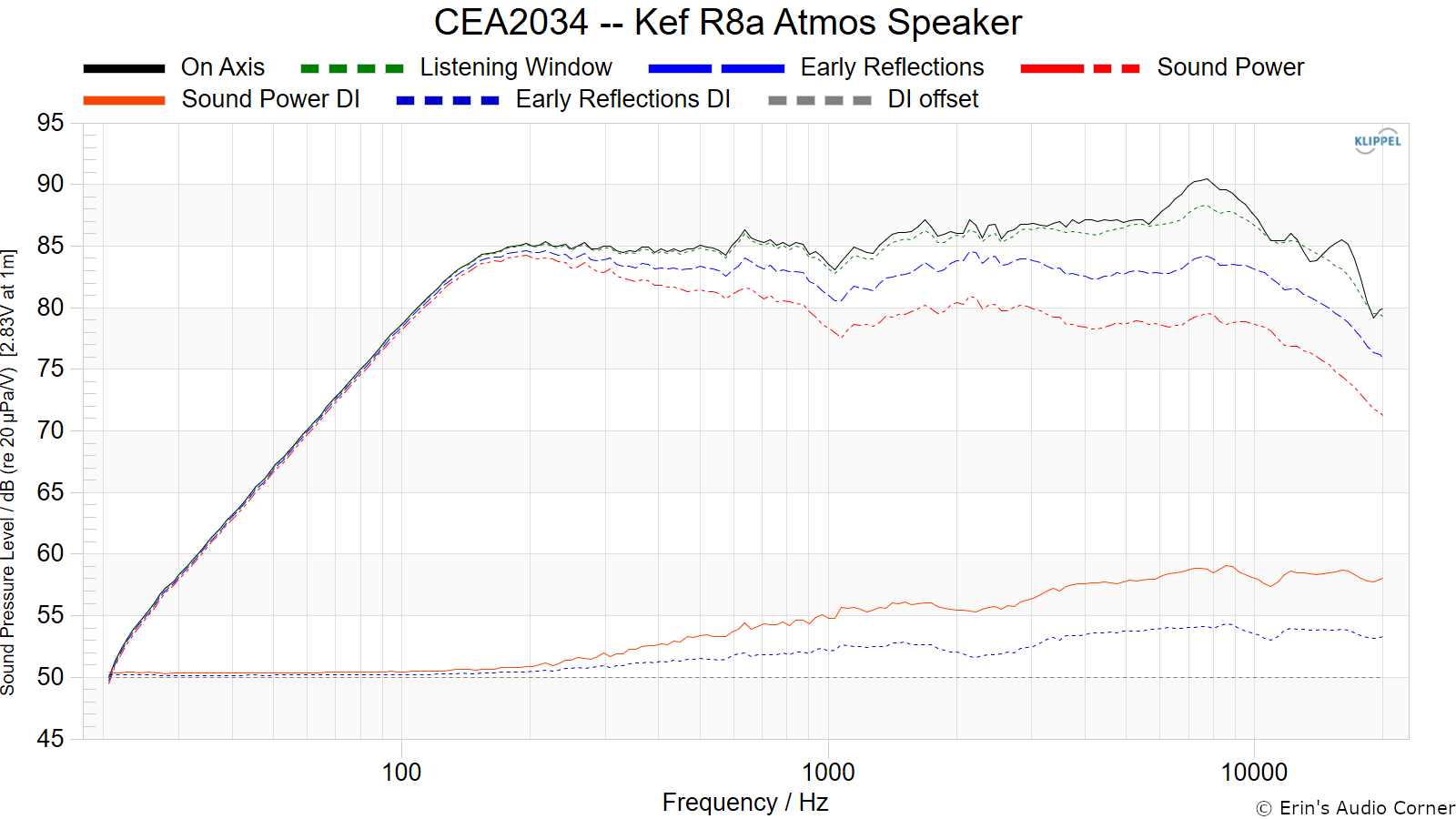
Early Reflections Breakout:
Floor bounce: average of 20º, 30º, 40º down
Ceiling bounce: average of 40º, 50º, 60º up
Front wall bounce: average of 0º, ± 10º, ± 20º, ± 30º horizontal
Side wall bounces: average of ± 40º, ± 50º, ± 60º, ± 70º, ± 80º horizontal
Rear wall bounces: average of 180º, ± 90º horizontal

Estimated In-Room Response:
In theory, with complete 360-degree anechoic data on a loudspeaker and sufficient acoustical and geometrical data on the listening room and its layout it would be possible to estimate with good precision what would be measured by an omnidirectional microphone located in the listening area of that room. By making some simplifying assumptions about the listening space, the data set described above permits a usefully accurate preview of how a given loudspeaker might perform in a typical domestic listening room. Obviously, there are no guarantees, because individual rooms can be acoustically aberrant. Sometimes rooms are excessively reflective (“live”) as happens in certain hot, humid climates, with certain styles of interior décor and in under-furnished rooms. Sometimes rooms are excessively “dead” as in other styles of décor and in some custom home theaters where acoustical treatment has been used excessively. This form of post processing is offered only as an estimate of what might happen in a domestic living space with carpet on the floor and a “normal” amount of seating, drapes and cabinetry.
For these limited circumstances it has been found that a usefully accurate Predicted In-Room (PIR) amplitude response, also known as a “room curve” is obtained by a weighted average consisting of 12 % listening window, 44 % early reflections and 44 % sound power. At very high frequencies errors can creep in because of excessive absorption, microphone directivity, and room geometry. These discrepancies are not considered to be of great importance.

Horizontal Frequency Response (0° to ±90°):

Vertical Frequency Response (0° to ±40°):

Horizontal Contour Plot (not normalized):
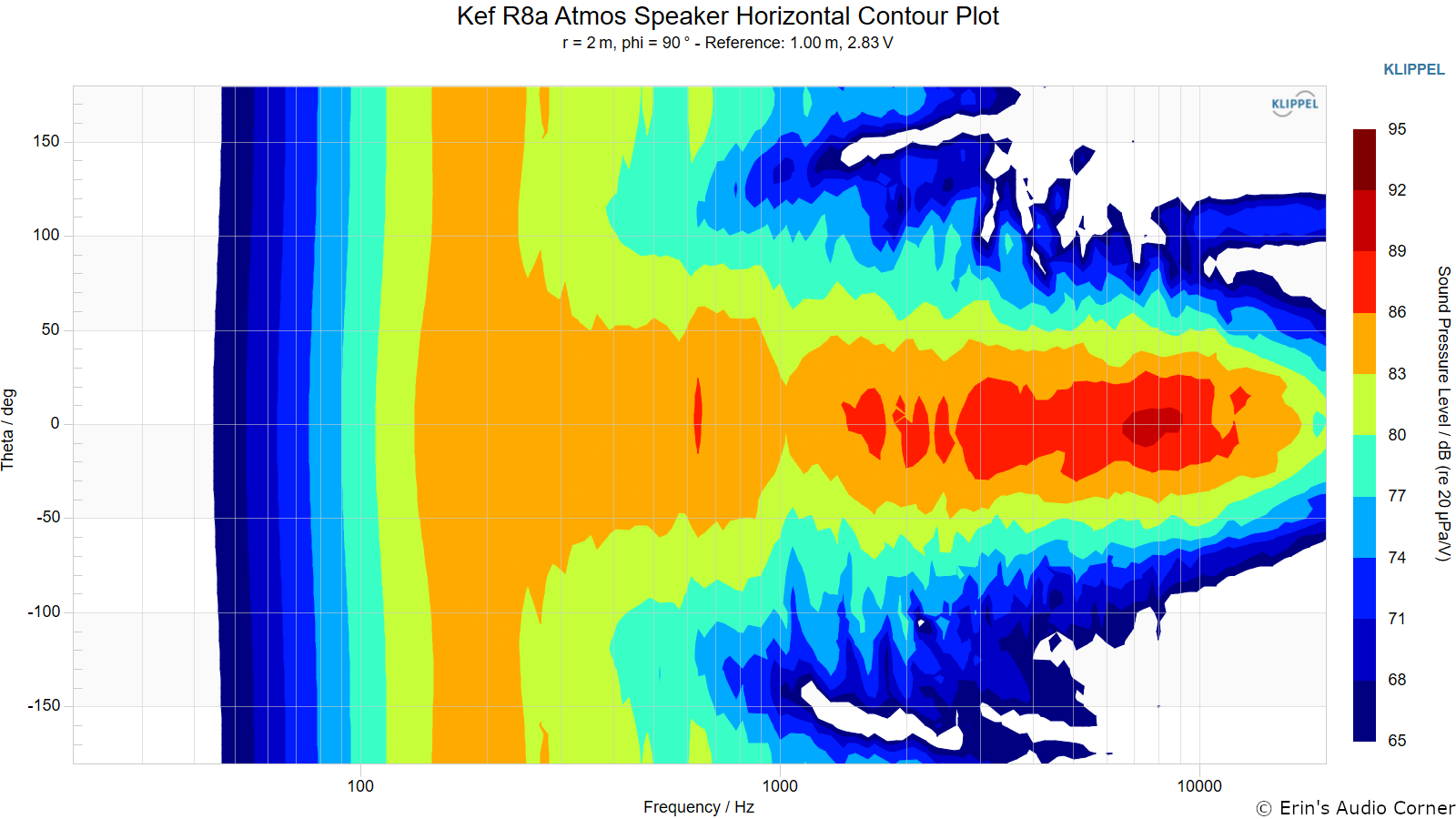
Vertical Contour Plot (not normalized):
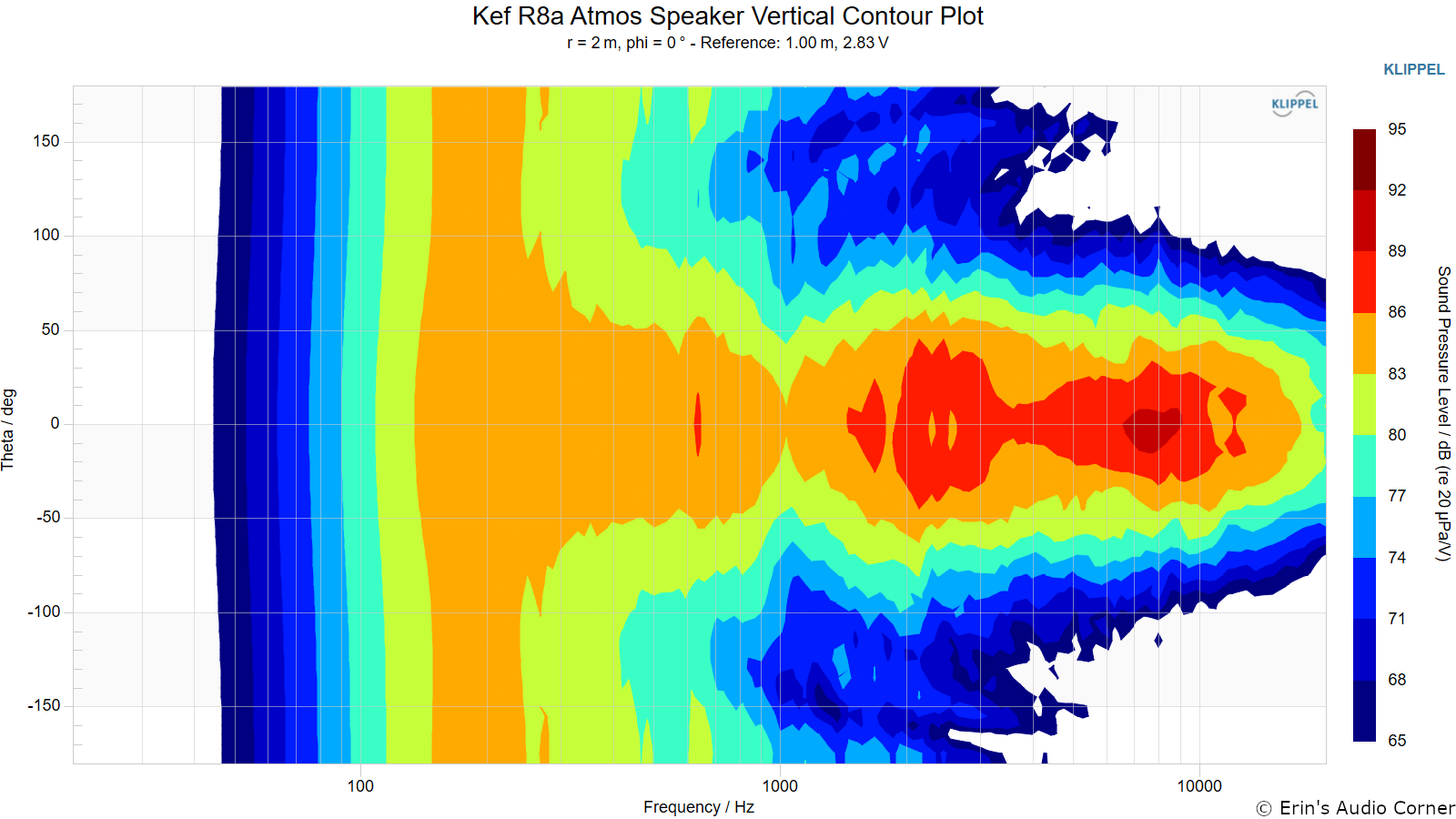
“Globe” Plots
Horizontal Polar (Globe) Plot:
This represents the sound field at 2 meters - above 200Hz - per the legend in the upper left.
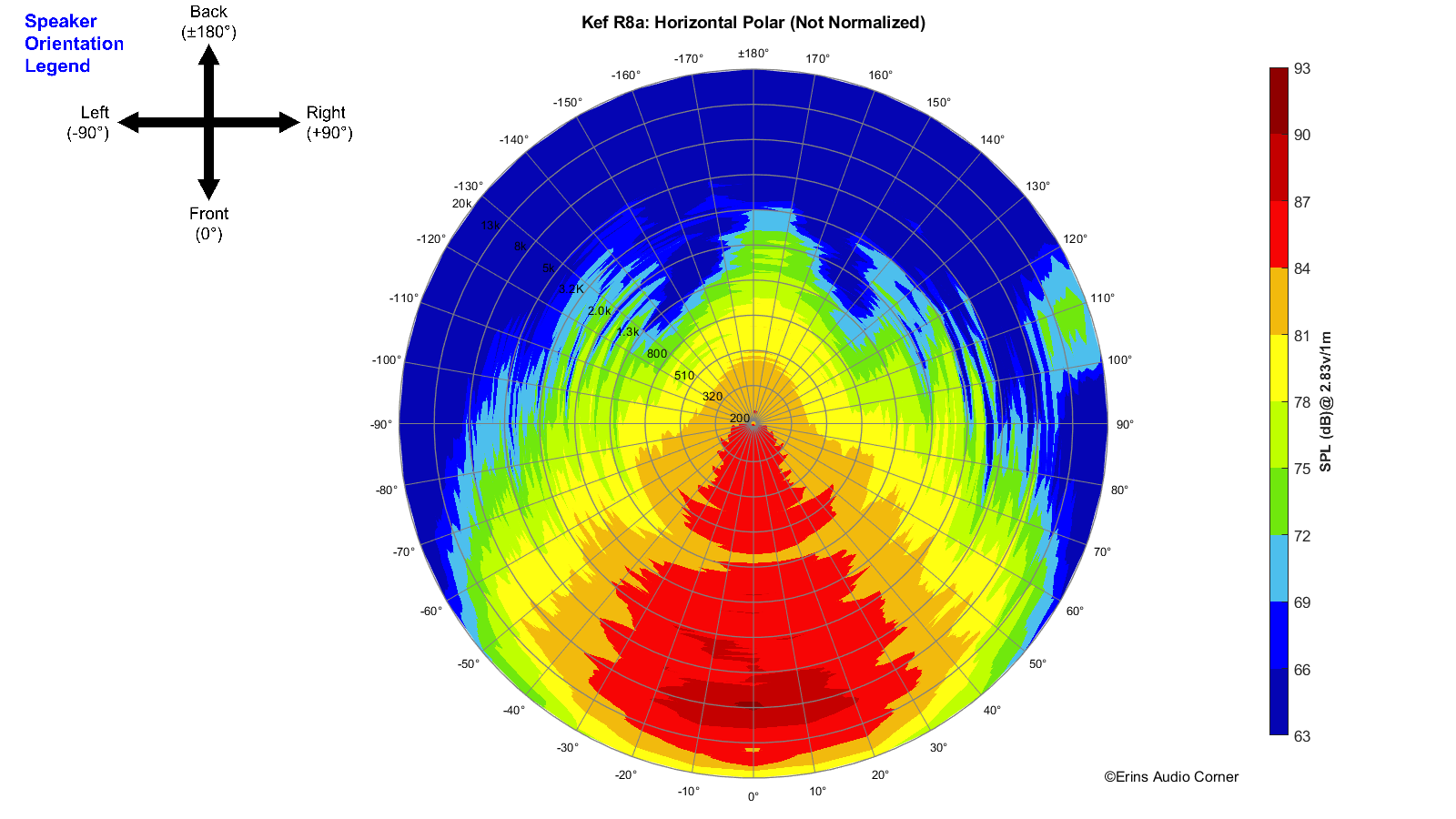
Vertical Polar (Globe) Plot:
This represents the sound field at 2 meters - above 200Hz - per the legend in the upper left.
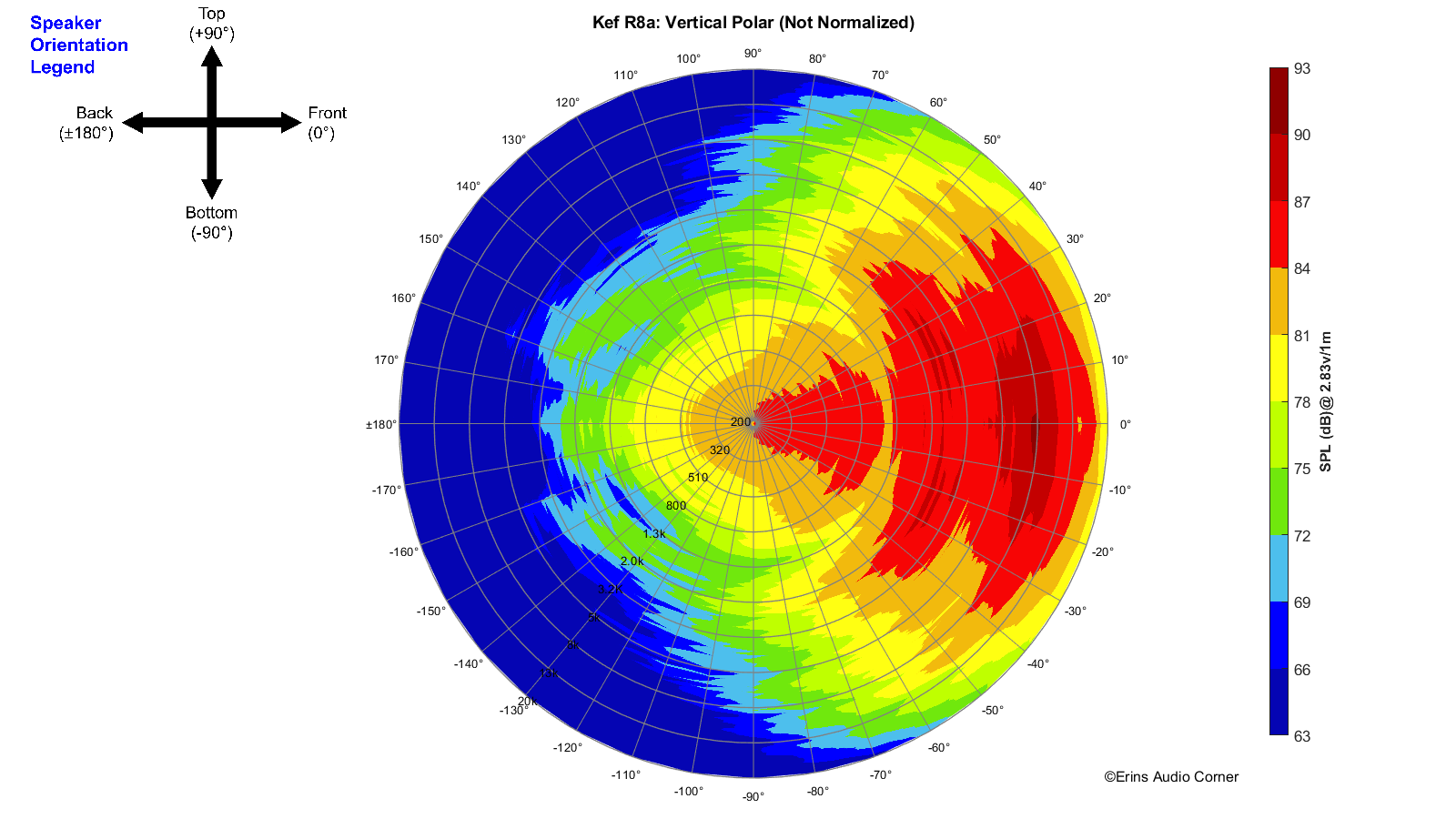
Additional Measurements
On-Axis Response Linearity
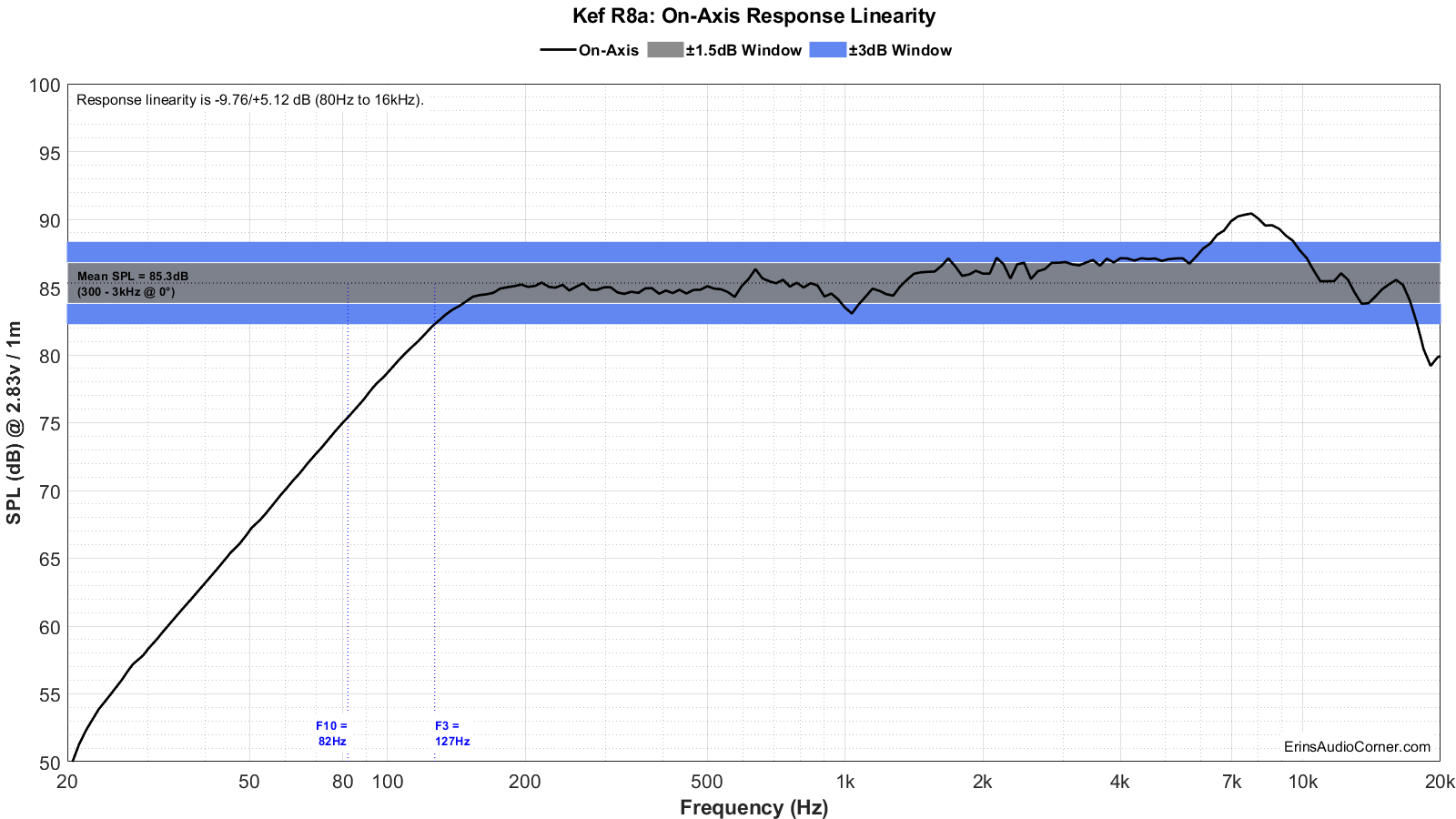
Impedance Magnitude and Phase + Equivalent Peak Dissipation Resistance (EPDR)
For those who do not know what EPDR is (ahem, myself until 2020), Keith Howard came up with this metric which he defined in a 2007 article for Stereophile as:
… simply the resistive load that would give rise to the same peak device dissipation as the speaker itself.
A note from Dr. Jack Oclee-Brown of Kef (who supplied the formula for calculating EPDR):
Just a note of caution that the EPDR derivation is based on a class-B output stage so it’s valid for typical class-AB amps but certainly not for class-A and probably has only marginal relevance for class-D amps (would love to hear from a class-D expert on this topic).
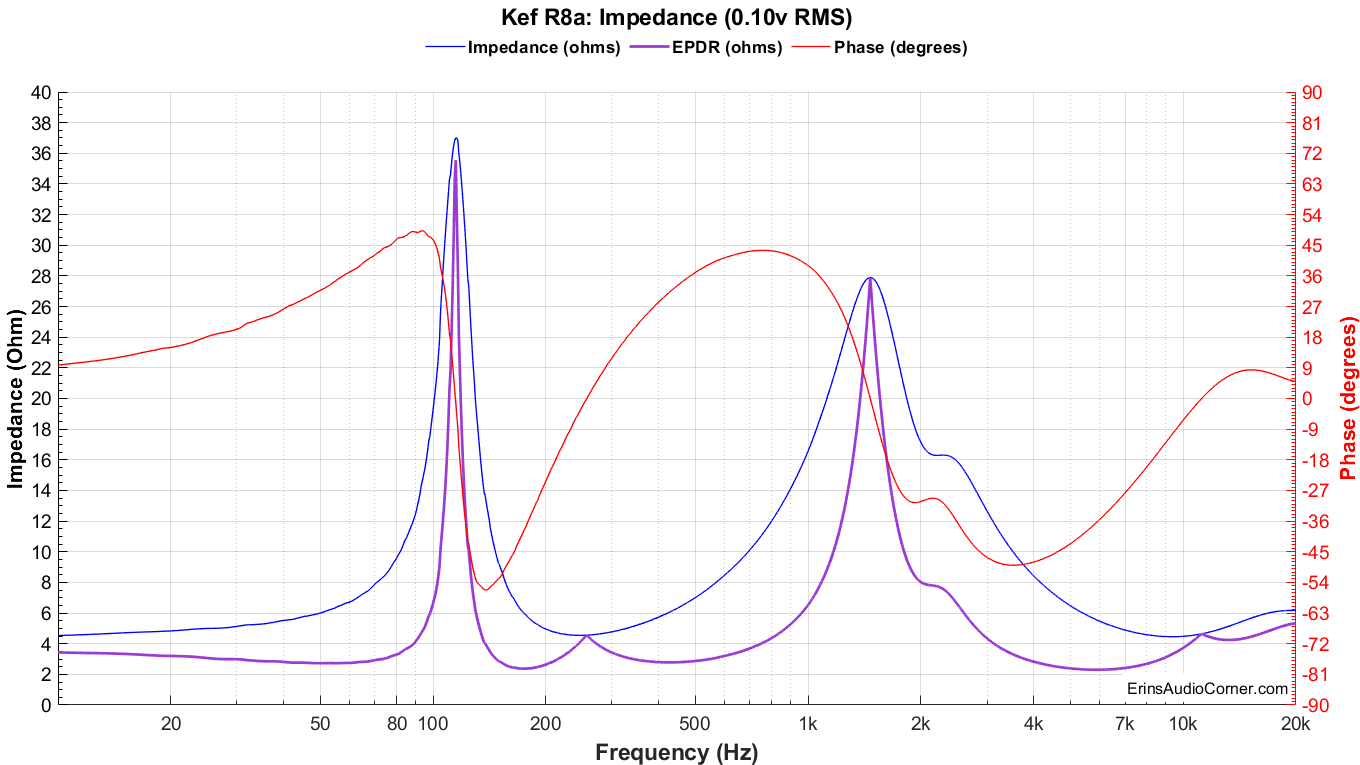
Harmonic Distortion
Harmonic Distortion at 86dB @ 1m:
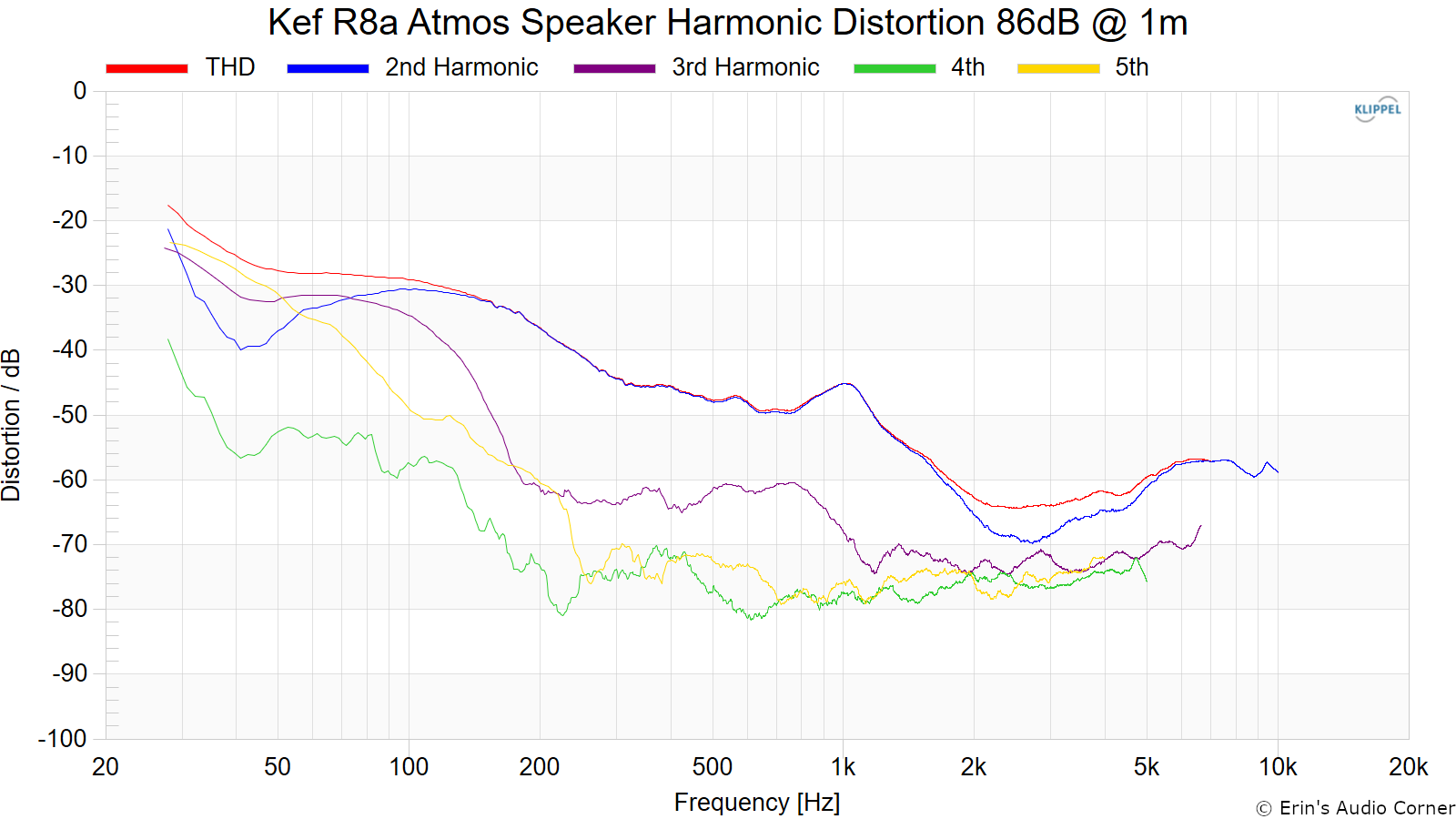
Harmonic Distortion at 96dB @ 1m:
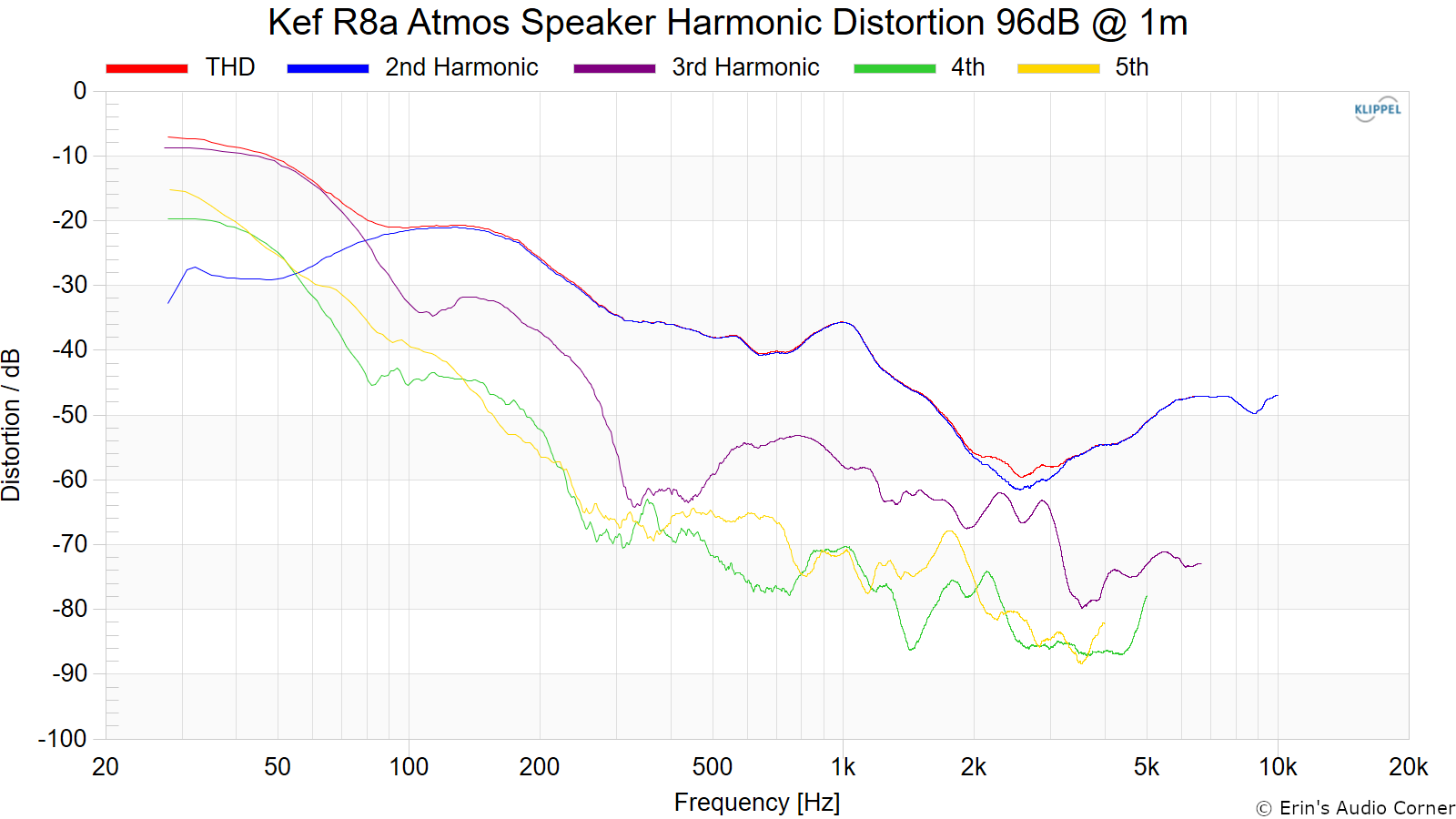
Dynamic Range (Instantaneous Compression Test)
The below graphic indicates just how much SPL is lost (compression) or gained (enhancement; usually due to distortion) when the speaker is played at higher output volumes instantly via a 2.7 second logarithmic sine sweep referenced to 76dB at 1 meter. The signals are played consecutively without any additional stimulus applied. Then normalized against the 76dB result.
The tests are conducted in this fashion:
- 76dB at 1 meter (baseline; black)
- 86dB at 1 meter (red)
- 96dB at 1 meter (blue)
- 102dB at 1 meter (purple)
The purpose of this test is to illustrate how much (if at all) the output changes as a speaker’s components temperature increases (i.e., voice coils, crossover components) instantaneously.
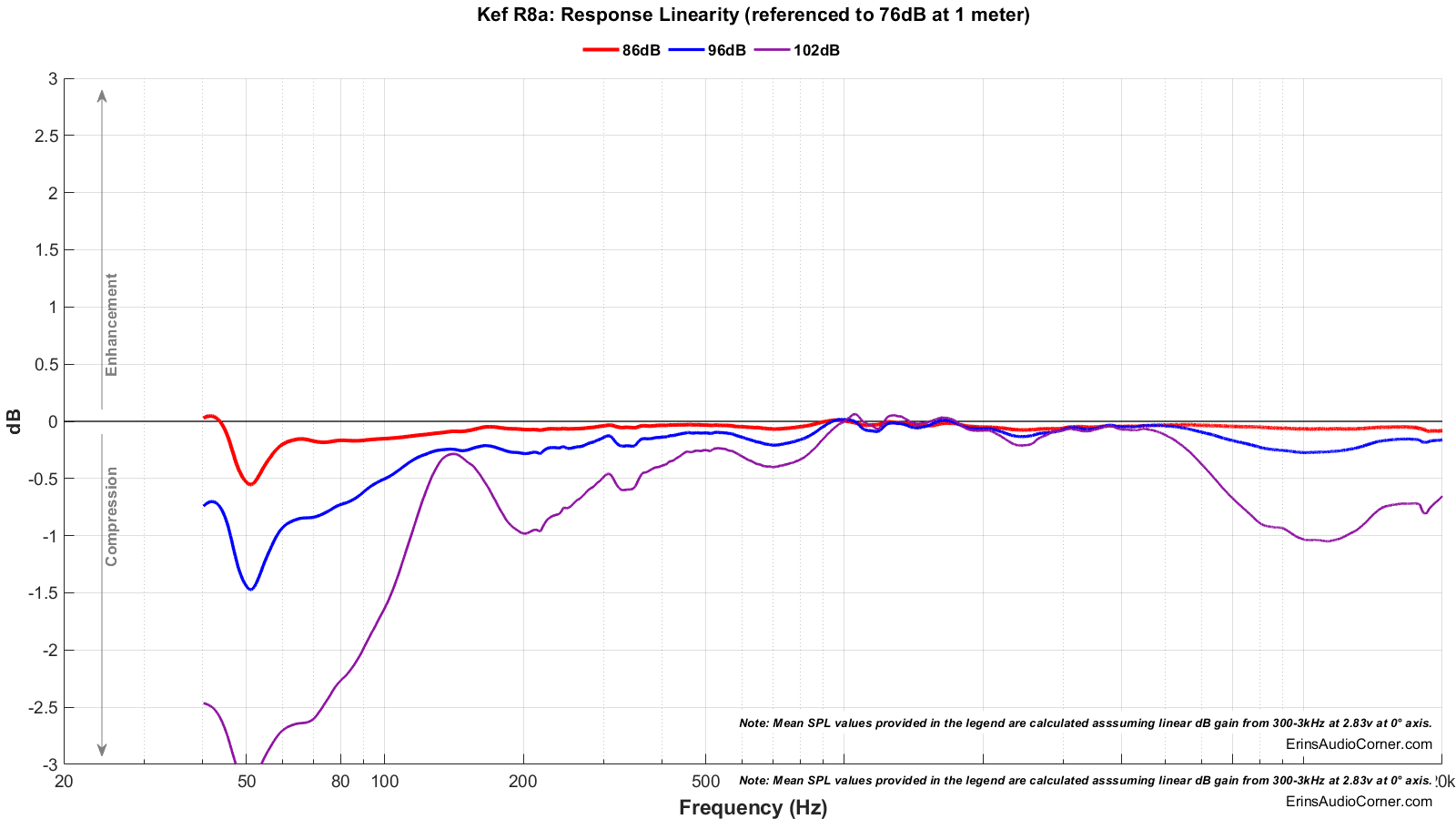
Based on my results above, it is obvious the output is limited (via internal DSP) somewhere above the 96dB @ 1m output level.
Long Term Compression Tests
The below graphics indicate how much SPL is lost or gained in the long-term as a speaker plays at the same output level for 2 minutes, in intervals. Each graphic represents a different SPL: 86dB and 96dB both at 1 meter.
The purpose of this test is to illustrate how much (if at all) the output changes as a speaker’s components temperature increases (i.e., voice coils, crossover components).
The tests are conducted in this fashion:
- “Cold” logarithmic sine sweep (no stimulus applied beforehand)
- Multitone stimulus played at desired SPL/distance for 2 minutes; intended to represent music signal
- Interim logarithmic sine sweep (no stimulus applied beforehand) (Red in graphic)
- Multitone stimulus played at desired SPL/distance for 2 minutes; intended to represent music signal
- Final logarithmic sine sweep (no stimulus applied beforehand) (Blue in graphic)
The red and blue lines represent changes in the output compared to the initial “cold” test.


Parting / Random Thoughts
If you want to see the music I use for evaluating speakers subjectively, see my Spotify playlist.
Listening was performed at about 4 meters away. In my listening session, I turned the speaker on its side (as opposed to facing up). I wanted to treat it more like a bookshelf to get an idea of its “ideal” listening space and reasonable conclusions can be made about positioning it in other ways after the fact (sitting on top of another speaker and facing up or wall-mounted pointed toward this listeners).
A few quick notes:
- I found max volume to be limited to 90dB when ran full range. When I placed a crossover on the speakers at 120Hz, the listening levels got a good bit higher, in the 90-95dB region depending on what I was listening to.
- Very neutral midrange that actually sounds really, really good. Very excellent speech intelligibility through the midrange and lower treble.
- The high frequency has a bump; presumably intentional because this speaker is designed to on top of the other Kef R-series speakers and fire upward (toward the ceiling). Given this, I assume the high frequency bump is intentional. However, when placed on a wall (using the key-holed brackets on the back of the speaker) and firing on-axis toward the listening area this can become problematic as, when facing forward, the wide Q bump comes off as fairly sibilant for one thing and possibly a bit too bright depending on how on-axis you are to the speaker. I turned the speaker a bit and listened and ultimately wound up facing the tweeter at about 30° off-axis and this yielded the best trade-off, knocking the sibilance down to agreeable levels.
- Additionally, if you do choose to mount the speaker to a wall, the response will suffer comb filtering; something not exclusive to this particular speaker (all speakers have this issue). I simply mention it because it is something to be aware of.
- Mild resonance around 600Hz that likely isn’t audible to most and wasn’t to me.
- Overall pretty good EQ-ability. Which is good for a home theater speaker as most everyone these days uses room equalization and this speaker will mostly take well to that, if you choose to do so.
- Mid sensitivity around 85dB. In a smaller home theater this is adequate but if you have a large home theater then you may find you need more volume, depending on how you have the channels routed to this speaker (meaning, if it gets full range signal or just spatial effects).
Overall, with the right placement, this is a good speaker. Do not aim this on-axis (or, if you do, make sure to use EQ to knock down the HF peaking from 6-10kHz). The midrange clarity - for me - is the standout of this speaker and it really is quite excellent.
Since these aren’t intended to be used as front mains, I can give it some slack on the inability to play low where you will definitely need a subwoofer. The F3 of this speaker is 127Hz. The distortion and compression data all support the notion that you should not expect to run this down to 80Hz to pair with mains or otherwise mimic the mains. Frankly, I wouldn’t run them below 100Hz. I’d be looking at a crossover at least in the 125Hz region. If not higher. This presents a bit of a struggle for me as a reviewer because - on one hand you can’t reasonably expect a speaker of this size to extend low, however, from what I can tell in the Dolby spec and have been told from reliable home theater installers, the Atmos speakers in a home theater should be very comparable in bandwidth to that of the mains. You’re simply not going to get that in this case. And therein lies the inner struggle of rationalizing the best use-case of this speaker vs what is sensible for the small overall size; something that is likely necessary for small-to-medium sized home theaters.
Support the Cause
If you like what you see here and want to help support the cause you might be interested in joining my Patreon, here. You can also contribute via PayPal (the big yellow button below).
Your support helps me pay for new items to test, hardware, miscellaneous items and costs of the site’s server space and bandwidth. All of which I otherwise pay out of pocket. So, if you can help chip in a few bucks, know that it is very much appreciated.
Alternatively, if you plan to purchase these speakers, please consider using my Amazon affiliate link below as it helps me gain a small (4%) commission at no additional cost to you.
You can also join my Facebook and YouTube pages if you’d like to follow along with updates.